Mastering Wind Gust Reports for Kiteboarding Success

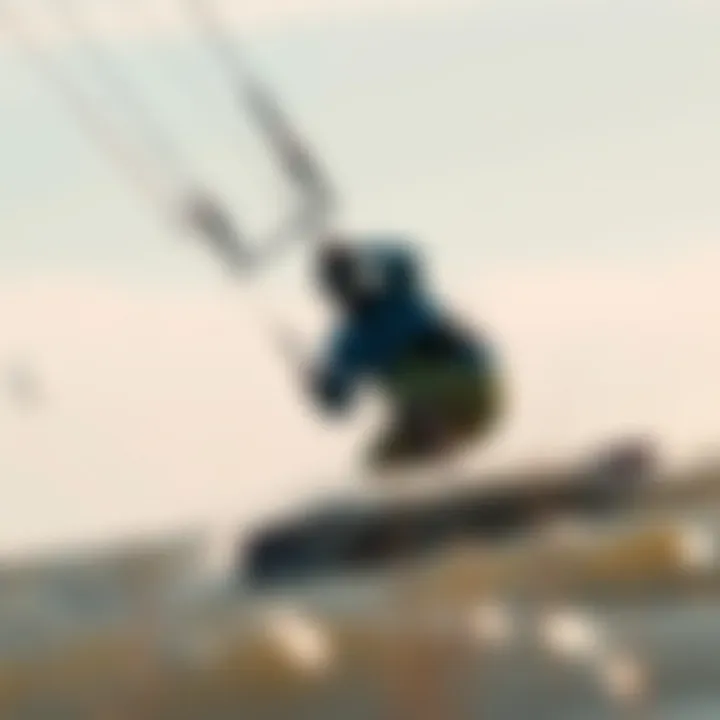
Intro
Kiteboarding is an exhilarating sport, a dance with wind and water that requires not just skill, but a keen understanding of various elements—most notably wind gusts. For those who are passionate about the sport, the whispers of the wind can turn a mediocre session into an unforgettable ride. Wind gust reports play a crucial role in this endeavor, and knowledge of how to interpret these reports isn’t merely an advantage, it’s a necessity.
Before you hit the water, grasping what wind gusts mean and how they can drastically affect your performance is essential. Understanding these forces helps you make informed decisions about when to launch your kite, which size to use, and how to handle unpredictable gusts during your ride. Whether you're a seasoned rider or just testing the waters, this guide takes a thorough look at the wind gust phenomenon, empowering you to harness the winds effectively.
In this article, we will dive into the intricate dynamics of wind gusts, examine measurement techniques, and explore their implications specifically tailored to kiteboarding. The aim is clear—to equip every kiteboarder with the insights needed to enhance their safety and enjoyment on the waves. Along the way, we will also touch on gear selection and skill development in relation to understanding wind conditions.
In the upcoming sections, allow us to be your compass guiding you through the often turbulent winds of kiteboarding, with a promise to make the experience as smooth as a calm sea beneath a sunny sky.
Intro to Wind Gusts
When it comes to kiteboarding, understanding the nuances of wind gusts can make the difference between an exhilarating ride and a precarious situation. Wind gusts aren’t just whimsical fluctuations in air; they are intricate phenomena shaped by a variety of factors that every kiteboarder should grasp fully. This section aims to unravel the essence of wind gusts and elucidate why they hold such significance for those who ride the waves.
Definition of Wind Gusts
Simply put, wind gusts refer to sudden bursts of wind that exceed the average sustained wind speed over a particular period. Unlike steady winds that provide a consistent push for your kite, gusts can appear unexpectedly and vary dramatically in strength. These fluctuations can be short-lived, lasting only a few seconds, but don’t let their brevity fool you; they can pack a powerful punch. Tuning into how these gusts differ from regular wind patterns can help you prepare for the conditions ahead and adjust your technique accordingly.
Wind gusts are typically measured in miles per hour or kilometers per hour and are usually reported alongside average wind speeds. For instance, a report might state winds of 15 mph with gusts up to 25 mph. This tells you at a glance that while the wind is generally steady, you might experience moments of increased intensity that could affect your control and stability on the water.
Importance in Kiteboarding
The significance of understanding wind gusts in kiteboarding cannot be overstated. The very essence of kiteboarding relies on the wind—its presence and its consistency. Here are a few reasons why kiteboarders should pay close attention to wind gust reports:
- Safety: Wind gusts can lead to unpredictable changes in your ride. Knowing their patterns helps you assess whether it’s safe to head out. For example, a sudden gust can turn a calm session into a risky situation faster than you can say "kite."
- Performance Optimization: By understanding gust behavior, you can optimize your performance. If you know gusts are expected, you might choose a smaller kite that handles fluctuations better, ensuring a more controlled experience.
- Technique Adjustment: Wind gusts require adjustments in your riding technique—perhaps adopting a lower center of gravity or shifting your weight more strategically. Mastering this can mean the difference between maintaining steady control or being thrown off balance.
- Planning Sessions: Wind patterns vary drastically based on geographical area and time of year. Some spots are notorious for gusty conditions, while others provide steady winds. Recognizing these trends allows you to plan your riding sessions more effectively.
"Awareness of wind gusts is synonymous to the foresight of a chess player—being prepared for all moves keeps you in command of your game."
In summary, the interplay between wind gusts and kiteboarding is complex yet crucial. By diving deeper into understanding these gusts, kiteboarders can enhance their experience and establish a higher level of safety, translating to more enjoyable outings on the water. This section sets the stage for further exploration into the science behind wind gusts, the techniques available for measuring them, and how they fundamentally influence kiteboarding performance.
The Science Behind Wind Gusts
Understanding the science behind wind gusts is crucial for kiteboarders who want to enhance their riding experience. Wind gusts can elevate risks and alter the performance of equipment, thus comprehending these physical phenomena helps in making educated decisions. It’s not just about grabbing a kite and heading out; the relationship between the environment and your kite is complex and one that every kiteboarder needs to grasp.
Meteorological Factors
Various meteorological factors contribute to the creation and behavior of wind gusts. Let’s delve into three significant aspects: temperature, pressure patterns, and topography.
Temperature
The temperature of the air plays a substantial role in creating wind currents. Warmer air tends to rise, leading to lower pressure areas that can exacerbate wind activity, including gusts. In kiteboarding, warmer conditions often mean thermals that can create unpredictable wind patterns. This characteristic is particularly relevant in coastal areas during summer; these breezy days can lead to exciting riding opportunities. However, wind temperatures should be monitored since rapid drops or spikes can lead to sudden gusts, which may challenge your control.
Pressure Patterns
Pressure patterns across regions create variations in wind speeds and directions. High-pressure systems usually indicate more stable conditions, while low-pressure areas can bring about turbulent winds and unpredictable gusts. This characteristic makes understanding pressure movements beneficial for planning kiteboarding sessions, ensuring riders pick the right time to hit the water. However, these patterns change frequently, and not accounting for them can lead to dangerous situations on the water.
Topography
The landscape surrounding a kiteboarding location has a significant impact on how wind gusts behave. Mountains and hills can channel winds, creating areas of increased speed as they move around obstacles. This unique feature means that two spots less than a mile apart can experience quite different wind conditions. For kiteboarders, knowing the topography can help anticipate where to ride on a given day. It is important to remember, though, that navigating these gusty currents can be tricky, making the understanding of local terrain invaluable.
Wind Measurement Techniques
Grasping the concepts around wind measurement tools enriches a kiteboarder's ability to respond accurately to wind gusts, ensuring a safer experience overall.
Anemometers
Anemometers are a staple in measuring wind speed and direction. They come in several forms, the most common being the traditional cup anemometer, which provides reliable data. The key characteristic of this tool is its simplicity and wide availability, making it ideal for both novice and seasoned kiteboarders alike. However, while they are excellent for general wind speed readings, they may lag in capturing rapid fluctuations, which is crucial during gusty conditions.
Sonic Anemometers
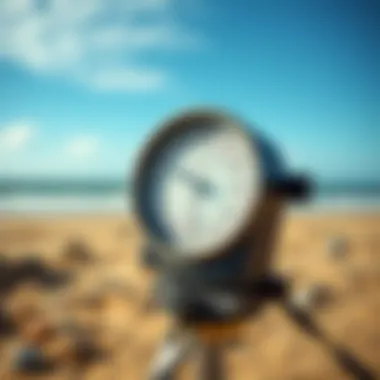
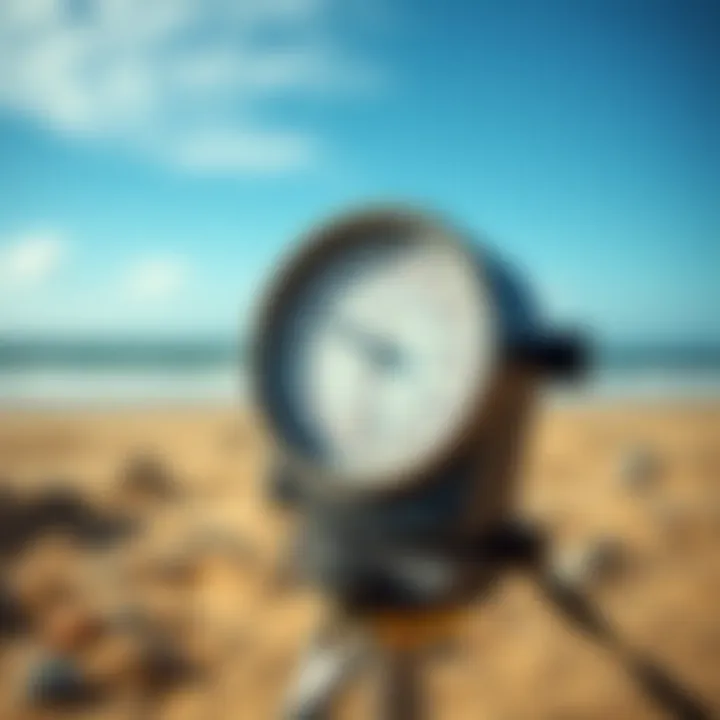
Moving on to sonic anemometers, which are a bit more sophisticated, these devices use sound waves to gauge wind speed and direction with high precision. This high-tech choice is particularly useful in very turbulent conditions, as they respond almost instantaneously to changes. Although more expensive and requiring a bit more know-how than basic models, their accuracy makes them a good investment for serious kiteboarders.
Cup Anemometers
Cup anemometers, another popular measurement tool, function based on rotating cups that catch the wind. They have a strong reputation for ease of use, contributing significantly to their popularity. Their unique feature lies in their robust design, which can endure harsh outdoor conditions. Although mostly dependable, they may not perform well in very light winds, sometimes missing those subtle gusts that present opportunities or dangers alike.
"A kiteboarder’s success hinges on the ability to interpret wind data accurately and swiftly. The right tools and an understanding of meteorological factors are essential."
Interpreting Wind Gust Reports
For kiteboarders, interpreting wind gust reports is a vital skill that can significantly enhance both the enjoyment and safety of the sport. Understanding how to read these reports allows riders to make informed decisions about when and where to hit the water. Mistaking a light breeze for a roaring gust could lead to dangerous situations. This section delves into various aspects of wind gust data, breaking it down to its fundamental elements so that practitioners can confidently navigate the conditions.
Understanding Data Formats
Units of Measurement
Units of measurement, such as miles per hour (mph) or meters per second (m/s), play a critical role in understanding wind gust reports. They provide a standardized way to quantify wind speed, making it easier for kiteboarders to assess the conditions before setting out. Most kiteboarding reports will typically use mph, which can offer clarity, especially for those who are familiar with imperial units.
One key characteristic of these units is that they can directly affect your performance on the water. Gusts reported in mph tend to be more relatable for those in North America. Conversely, metrics like m/s might be preferred in Europe. In either case, knowing the unit is crucial for accurate interpretation.
However, there are unique features to consider. Gusts can vary significantly even within a low measurement range. A 5 mph gust might feel different based on local geography or obstructions, such as buildings or trees. Understanding these subtleties can help kiteboarders choose their gear and plan their activities better.
Reporting Standards
Reporting standards refer to the methodologies used to present wind gust data. These standards ensure consistency across various platforms, such as websites, mobile applications, and traditional forecasts. When kiteboarders encounter reports, it’s advisable to know how the data is collected. For example, are the measurements taken at sea level, or do they account for elevation?
A key characteristic of these reporting standards is that they often include not just the gust speed but additional context, such as the duration of the gust, which can be particularly helpful. This context is a beneficial aspect, as kiteboarders can prepare more accurately based on expected performance conditions.
It’s worth noting that while most kiteboarding enthusiasts rely on a handful of trusted sources, the variance in reporting standards can lead to confusion. Understanding how to assess these standards allows practitioners to read the reports critically and avoid relying solely on one data point.
Reading Wind Reports
Hourly Reports
Hourly reports provide wind gust data that is crucial for planning a kiteboarding session. These reports summarize the wind conditions for every hour of the day, offering a snapshot that can help riders identify peak times for wind intensity. The key characteristic is consistency; these reports allow users to anticipate changes throughout the day. For example, a report indicating stronger gusts in the afternoon can prompt kiteboarders to shift their schedule accordingly.
Additionally, hourly reports often allow for the comparison of gusts over a more extended period. This benefit makes them a popular choice among kiteboarders who prefer to monitor conditions throughout the day instead of relying on sporadic updates. However, one limitation to watch out for is the potential for stale data; if a rider looks at an hour-old report, conditions may have changed.
Real-Time Updates
In contrast, real-time updates provide the most immediate insights for kiteboarders. With the increasing use of technology, many applications now offer live gust reports that reflect current conditions. Riders can get alerts when gusts exceed a certain speed, helping them avoid hazardous situations when conditions are suddenly unfavorable.
A significant benefit of these real-time reports is that they can help kiteboarders respond quickly to the dynamic nature of wind. They are especially useful during sessions, as conditions can change rapidly due to shifting weather patterns.
While real-time updates are marvelous, potential downsides include the reliance on technology. Signal issues or app deficiencies can occasionally cause delays or inaccuracies in data, leaving riders scrambling for reliable information. Therefore, it emphasizes the importance of being resourceful and consulting multiple sources if possible.
"For kiteboarders, the wind is not just a factor; it’s an ally and an adversary. Understanding gust reports empowers riders to dance with its whims."
In summation, recognizing how to interpret wind gust reports offers kiteboarders a distinct advantage, equipping them with the knowledge to assess safety and performance effectively. Following the nuances in units of measurement, reporting standards, and the differences between hourly reports and real-time updates will serve riders well in their adventures on the water.
Wind Conditions and Kiteboarding Performance
Wind conditions are at the heart of kiteboarding. For enthusiasts out on the water, getting a grip on how wind affects performance is crucial. Understanding how various elements play into wind dynamics can sharpen both the enjoyment and safety of a session. Kiteboarders must be able to interpret those gusty winds and what they imply for their ride.
Optimal Wind Conditions
Sustained Winds vs. Gusts
Sustained winds are those steady and reliable breezes that make for smooth sailing on the water. They provide a consistent pull on the kite, allowing riders to maintain control and execute tricks without any unwanted surprises. On the other hand, wind gusts can add an unpredictable nature to the experience.
When breaching the subject of sustained winds vs. gusts, one finds a defining characteristic: consistency. Sustained winds hover around a specific strength, usually measured over a period, ensuring that kiteboarders are less likely to experience any abrupt changes in pressure. Gusts, however, can surge suddenly, elevating the intensity of the wind momentarily and catching some riders off guard.


A primary advantage of sustained winds is the ease of maneuverability. They allow riders to plan their moves ahead of time without worrying constantly about fluctuations. In contrast, gusts might be thrilling, pushing the limits of one's skill, but they can also compromise stability, leading to mishaps if not managed judiciously.
Wind Direction and Its Impact
Wind direction plays a pivotal role in kiteboarding success. The way the wind approaches the riding area can make or break the experience. A favorable wind direction will propel the kite efficiently, providing that lift needed to catch air. However, if winds are cross-shore or directly onshore, it can lead to complications, such as difficulty in taking off or landing safely.
The ideal wind direction tends to come from a stable angle toward the shore. This setup allows for more straightforward navigation and offers riders a sense of power without the fear of being overpowered. Knowing how to assess wind direction is a skill every kiteboarder should cultivate; it directly influences not only performance but also safety.
Based on all this, one could see the unique features of wind direction shaping the riding landscape. When wind is blowing straight onto the beach, it's often considered gust-friendly and can lead to higher gains in airtime. Conversely, misunderstood wind direction can catch many kiteboarders, as they find themselves caught in uncertain waters, struggling to maintain control.
Effects of Wind Gusts on Riding
Wind gusts can introduce an entirely different flavor to a session. Those abrupt surges can either electrify a ride or bring it to a stumbling halt, largely basing the outcome on the rider's level of skill and understanding. Recognizing how gusts interact with the kite and the rider may enhance decision-making on the water.
Control and Stability
Control and stability are paramount when kiteboarding. With wind gusts presenting a volatile environment, the rider's ability to keep the kite steady becomes vitally important. When gusts hit, they can disrupt the smooth flow a rider usually enjoys, leading to an erratic ride. Understanding how to manage these gusts can be a game changer. For example, when a gust hits, a rider may need to adjust their weight distribution or reposition the kite to counterbalance the sudden force. This ability to read and adapt to changing conditions not only boosts confidence but can help avoid mishaps.
Performance Variations
Performance variations due to wind gusts can be quite stark. A kiteboarder may find themselves soaring higher than anticipated during a gust, or conversely, struggling to maintain control. These fluctuations can affect timing, leading to missed opportunities for tricks or jumps.
The impact of these wind factors should not be undervalued; an experienced kiteboarder soon learns to merge their riding style with gust patterns, enhancing their overall performance. Being able to predict and utilize gusts can lead to a more exhilarating ride—or at least one that��’s safer and less unpredictable.
"Understanding the nuances of wind conditions is what separates casual riders from those truly passionate about kiteboarding. The thrill is in mastering those elements, ensuring every session counts."
In sum, navigating wind conditions effectively is crucial for kiteboarders. Sustained winds provide a solid foundation, while the knowledge of gusts can elevate the riding experience, ensuring optimal performance and safety in every ride.
Safety Considerations
Safety plays a pivotal role in kiteboarding, especially when it comes to understanding wind gust reports. Kiteboarders must recognize that wind conditions can shift rapidly, leading to potentially dangerous situations. Having a clear grasp of safety guidelines not only protects the rider but also ensures a more enjoyable experience on the water. This section highlights key elements related to assessing risks and best practices for kiteboarding in gusty conditions.
Assessing Risks Associated with Wind Gusts
Understanding Vulnerabilities
In the realm of kiteboarding, understanding vulnerabilities is crucial for any rider who wishes to navigate the winds safely. Riders often underestimate how gusty winds can impact their equipment and control. For instance, a sudden increase in wind speed can send even an experienced kiteboarder tumbling into unexpected territory, leading to injuries. Identifying these vulnerabilities allows kiteboarders to prepare appropriately, such as choosing the right gear that can withstand varying wind conditions. A key characteristic of recognizing vulnerabilities is awareness. When a rider can track how wind patterns behave, they gain confidence and reduce anxiety when faced with sudden changes. This aspect of understanding helps kiteboarders make informed decisions about when to hit the water and when to hold back, ultimately enhancing safety.
Gusty Conditions and Gear Limitations
Gear limitations are another significant factor in kiteboarding safety. Gusty conditions can quickly expose weaknesses in equipment, potentially leading to catastrophic failures. Kite size is particularly crucial; if it’s too large for the current conditions, a kite can easily become uncontrollable during a gust. Furthermore, a key characteristic of gear limitations is its influence on performance. A kiteboarder equipped with quality gear built for gusty conditions often experiences smoother rides and improved safety. Choosing adequate gear, such as kites designed specifically for high-wind scenarios, can make all the difference. However, this comes with a trade-off since high-performance equipment may require more skill to control. Thus, knowing one’s own limits in relation to their gear is essential for any serious kiteboarder.
Best Practices for Kiteboarders
Choosing the Right Gear
Selecting the right gear goes beyond just aesthetics or brand recognition; it centers around performance and safety in various wind conditions. Appropriate kite size, board type, and safety accessories can drastically improve a kiteboarder's experience. A key consideration in this choice is how well gear can adapt to sudden gusts. For instance, smaller kites may provide better control when conditions become unpredictable, whereas larger kites excel in sustained winds. This aspect not only emphasizes personal preference but also the importance of situational awareness. Kiteboarders have to assess their environment as well as their own skill level before gearing up. Choosing the right gear can act as a safeguard against accidents and enhances overall performance.
Maintaining Awareness
Maintaining awareness is vital for safety during kiteboarding. This entails keeping an eye on both the wind conditions and one’s surroundings. Factors like changing weather patterns, choppy water, and even fellow riders can influence the overall experience. A kiteboarder's ability to swiftly respond to these dynamic elements can make a distinct difference between a thrilling ride and a hazardous situation. Regularly checking wind reports and forecasts can significantly enhance this practice. One unique feature of maintaining awareness is the concept of active listening and observation. Riders need to listen to the wind and watch for visual indicators such as water surface changes, which can signal gusts. This vigilant approach ensures that kiteboarders can quickly adapt or retreat if conditions become unfavorable, thereby ensuring their safety on the water.
"Wind can be unpredictable, but a prepared kiteboarder can turn challenges into thrilling rides!"
By understanding the risks inherent in wind gusts and adhering to best practices, kiteboarders can optimize their safety, performance, and enjoyment on the water. In summary, a keen awareness of wind conditions, gear limitations, and overall best practices not only contributes to safer kiteboarding adventures but also cultivates a culture of care within the community. Educated kiteboarders directly influence the safety standards on which all enthusiasts rely.
Technological Advances in Wind Reporting
In the realm of kiteboarding, keeping an eye on wind conditions can be the difference between an exhilarating session and a risky venture. The advancement of technology in wind reporting has transformed how kiteboarders interpret wind gusts and utilize their data. Now, with tools that adapt and improve over time, understanding wind gusts becomes a breeze, allowing riders to make better decisions on the water.
Innovations in Data Collection
Remote Sensing Technologies
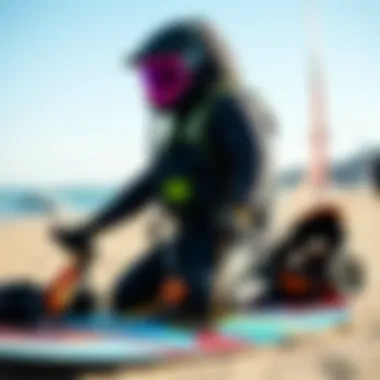
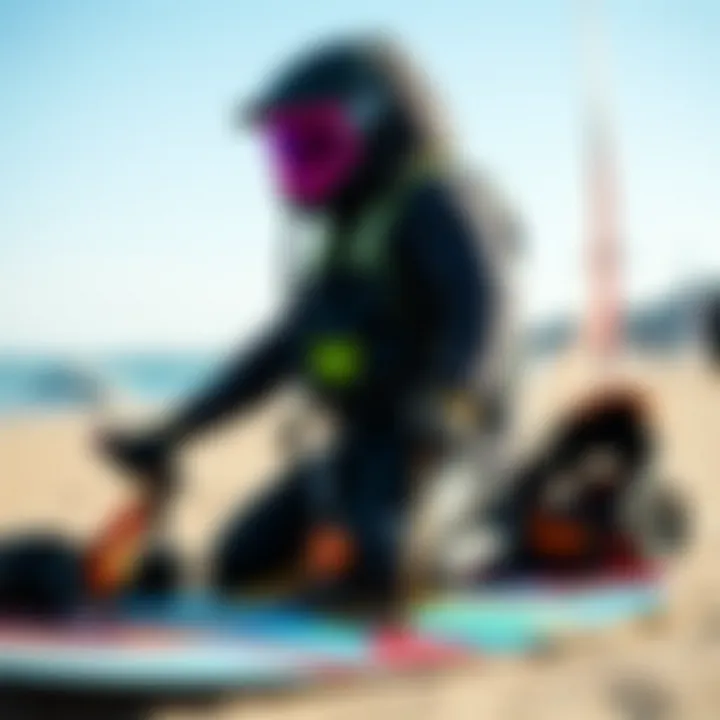
Remote sensing technologies play a pivotal role in modern wind reporting. These systems gather data from a distance, providing accurate readings without requiring direct contact with the elements. A prime attribute of these technologies is their ability to monitor vast areas swiftly. This unique aspect is a great fit for kiteboarders who often traverse different locations in search of the best wind conditions.
One standout feature of remote sensing is its adaptability to varying topographies and weather systems. The advantages are clear: you get real-time updates on atmospheric conditions that might change in a matter of seconds, ensuring that you're always clued in. However, there are downsides. The initial investment and setup can be steep, and on occasion, the data interpretation might miss finer, localized phenomena that directly affect riding conditions.
Crowdsourced Data Platforms
Crowdsourced data platforms have emerged as a prominent source of wind information for kiteboarders. These platforms rely on input from users in real-time, enhancing the richness and the speed of the data collected. A key characteristic here is the community involvement; riders contribute their own observations, creating a collaborative and shared forecast experience. This makes it especially appealing for those chasing the latest wind reports before heading out.
Moreover, the unique feature of these platforms is the immediate feedback loop that exists. Users can see how other kiters experience the same conditions, which can be invaluable when planning a session. On the flip side, the quality of data can be inconsistent, as not all contributions might meet certain reliability standards. Accuracy hinges on the user community's engagement and expertise.
Utilizing Mobile Applications
Features to Look For
When it comes to mobile applications for wind reporting, certain features can significantly enhance the kiteboarding experience. The primary aspect to seek is real-time wind updates; think live wind speeds and gust data at your preferred spots. This dynamism allows riders to make split-second decisions when conditions change unexpectedly.
Another notable feature is alerts and notifications. This functionality is beneficial as it notifies you about changing wind conditions, helping to prevent unexpected surprises while you’re gearing up or riding. Yet, one downside could be the overload of notifications; you wouldn’t want your phone buzzing for every minor gust possibly like your enthusiasm is deflated by too many updates that aren't truly relevant.
Popular Choices Among Kiteboarders
Among kiteboarders, the most popular mobile applications tend to be those that harmonize accuracy with user-friendliness. For instance, Windy and Windy.app have garnered a dedicated user base because of their streamlined interfaces and comprehensive data delivery. These applications provide kiteboarders with localized forecasts, which are much more precise for their needs compared to general weather stations.
The strong suite lies in integrating multiple data sources into one app; this promotes a sense of clarity in understanding the often chaotic nature of wind patterns. However, the trade-off might be that some features are behind paywalls, meaning that the best experience might not come free. Thus, kiteboarders must weigh cost against the benefits of obtaining quality updates.
"The winds of change can guide you; it's all about riding them smartly."
Regional Variations in Wind Gust Patterns
Understanding the regional variations in wind gust patterns is crucial for kiteboarders who aim to optimize their performance and ensure their safety on the water. Geographic factors play a pivotal role in influencing wind behavior, and failing to grasp these nuances may lead to missed opportunities or even dangerous conditions. Recognizing how different environments affect wind gusts can empower kiteboarders to make informed choices that enhance their experience.
Coastal vs. Inland Areas
The distinction between coastal and inland areas is foundational when examining wind gust patterns. Coastal regions are often characterized by stronger and more consistent winds due to the unobstructed path the wind travels over the open water. Here are some specific points to consider:
- Sustained Winds: Coastal areas typically have steady winds because the sea surface helps stabilize wind patterns, especially during the day when land breezes form. This consistency is ideal for kiteboarding.
- Gust Potential: However, this does not mean that coastal areas are free from gusts. Sea breezes can lead to sudden changes, and the stronger the wind, the more unpredictable gusts can become. This is vital for kiteboarders to monitor.
- Obstructions: In contrast, inland areas often have more obstructions such as trees and buildings. These structures disrupt wind flow, leading to turbulent and often unpredictable gusts. Riders in these areas might find conditions more variable, which could affect both performance and safety.
In summary, by knowing the distinct behaviors of winds in coastal and inland areas, kiteboarders can better prepare and adapt their techniques based on expected gust patterns.
Impact of Seasonal Changes
As seasons shift, the characteristics of wind also change, which can significantly impact kiteboarding conditions throughout the year. For kiteboarders, it is essential to stay alert to these seasonal variations for optimal performance.
- Winter vs. Summer: In many regions, winter gales can produce intense wind gusts due to strong pressure gradients. On the flip side, summer days might bring slightly more stable winds, though thunderstorms can introduce unpredictable gusts. Kiteboarders should brace themselves for the short, sharp gusts common during summer storms.
- Temperature Variations: Seasonal temperature differences can affect local wind patterns as well. The warming of land faster than water can create localized wind systems, especially in spring. These variations can lead kiteboarders to anticipate wind shifts throughout the day.
- Storm Systems: Additionally, it's important to pay attention to seasonal patterns in storm systems. Fall might bring the tail-end of hurricane season, bringing along strong, gusty conditions. Advanced preparation and knowledge can make the difference between a thrilling ride and a risky endeavor.
Understanding the impact of seasonal changes on wind gust patterns empowers kiteboarders by aiding them in anticipating conditions, making informed choices for their gear, and planning their sessions accordingly.
"Every wind tells a story; knowing the tale it weaves in your region leads to a safer and more enjoyable kiteboarding adventure."
Monitoring local weather reports and using reliable apps can provide real-time insights on wind patterns, greatly benefitting kiteboarders as they navigate their sporting experience. Explore resources like NOAA or Windy for valuable insights into seasonal wind forecasting.
Culmination
Understanding wind gust reports is not just a marginal element of kiteboarding; it’s an indispensable part of the sport. The insights gained from these reports can significantly influence a kiteboarder's experience, both positively and negatively. Here, we recap the crux of what has been discussed.
Recap of Key Insights
Wind gusts are erratic and can transform an idyllic day on the water into a challenging situation. Having a solid grasp of how to interpret wind gust data allows kiteboarders to assess conditions with a critical eye. Key takeaways from this article include:
- Definition and Importance: Wind gusts are brief, powerful bursts of wind which can deeply affect your performance on the water. Recognizing their impact helps in making informed choices.
- Meteorological Insights: Understanding the scientific underpinnings, including temperature fluctuations, pressure changes, and the influence of geography, provides clarity on what one might expect in varying locations.
- Reading Reports: Familiarity with various wind report formats—from hourly updates to real-time apps—empowers users to gauge conditions accurately.
- Safety: The risks associated with wind gusts cannot be overstated. Assessing these risks allows kiteboarders to protect themselves and their equipment, ensuring a safer experience.
- Technological Advances: Utilizing modern data collection methods and mobile applications enables kiteboarders to access timely and precise weather information.
- Regional Patterns: Recognizing that wind conditions differ vastly between coastal and inland areas, or across seasons, can greatly improve one’s adaptability to different kiteboarding environments.
The Future of Wind Reporting in Kiteboarding
As kiteboarding evolves, so too must the approaches we take toward understanding and reporting wind conditions. The incorporation of advanced technologies, such as AI-driven forecasting, stands to redefine how kiteboarders access and interpret wind gust information. Mobile applications are likely to become more sophisticated, offering features like real-time alerts and localized data gleaned from IoT sensors. Furthermore, crowdsourced platforms may emerge as new avenues for reporting, where kiteboarders can share live conditions affecting specific spots.
The challenge will remain for kiteboarders to synthesize these advancements into practical, real-world strategies. Engaging with the community—both local and online—will play a crucial role in shaping the future of this data. It's imperative that kiteboarders stay tuned to developments in meteorological science and technological innovations, as this not only enhances personal enjoyment but also contributes to a greater understanding of wind conditions that impact the sport collectively.
In summary, as kiteboarding continues to grow, so does the need for precise and accessible wind reporting. By navigating these changes with an informed mindset, kiteboarders can further hone their skills, maximize their enjoyment, and ensure their safety on the water.















